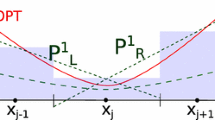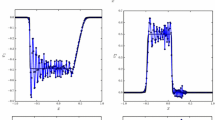Abstract
An entropy-stable residual distribution (RD) method is developed for the systems of two-dimensional shallow water equations (SWE). The construction of entropy stability for the residual distribution method is derived from finite volume method principles, albeit using a multidimensional approach. The paper delves into in-depth discussions on how finite volume methods achieve entropy stability in a “one-dimensional” sense for two-dimensional systems of SWE unlike the residual distribution methods. Results herein demonstrate the superiority of the entropy-stable RD methods relative to their finite volume counterparts, especially on highly irregular triangular grids. The comparative results with other established RD methods are also included, depicting similar performances with the Lax–Wendroff method for unsteady smooth flows but more accurate than the multidimensional upwind approaches (N, LDA) on both smooth and discontinuous test cases.














Similar content being viewed by others
References
Abgrall, R.: Residual distribution schemes: current status and future trends. Comput. Fluids 35(7), 641–669 (2006)
Abgrall, R.: A general framework to construct schemes satisfying additional conservation relations. Application to entropy conservative and entropy dissipative schemes. J. Comput. Phys. 372, 640–666 (2018)
Abgrall, R., Mezine, M.: Construction of second order accurate monotone and stable residual distribution schemes for unsteady flow. J. Comput. Phys. 188(1), 16–55 (2003)
Abgrall, R., Roe, P.: High-order fluctuation schemes on triangular meshes. J. Sci. Comput. 19(1), 3–36 (2003)
Barth, T.: An introduction to recent developments in theory and numerics of conservation laws. In: Numerical Methods for Gas-Dynamic Systems on Unstructured Meshes (1999)
Chandrashekar, P.: Kinetic energy preserving and entropy stable finite volume schemes for compressible Euler and Navier–Stokes equations. Commun. Comput. Phys. 14(5), 1252–1286 (2013)
Chizari, H., Ismail, F.: Accuracy variations in residual distribution and finite volume methods on triangular grids. Bull. Malays. Math. Sci. Soc. 22, 1–34 (2015)
Chizari, H., Ismail, F.: A grid-insensitive LDA method on triangular grids solving the system of Euler equations. J. Sci. Comput. 71(2), 839–874 (2017)
Chizari, H., Singh, V., Ismail, F.: Developments of entropy-stable residual distribution methods for conservation laws II: system of Euler equations. J. Comput. Phys. 330, 1093–1115 (2017)
Csík, A., Ricchiuto, M., Deconinck, H.: A conservative formulation of the multidimensional upwind residual distribution schemes for general nonlinear conservation laws. J. Comput. Phys. 179(1), 286–312 (2002)
Deconinck, H., Sermeus, K., Abgrall, R.: Status of multidimensional upwind residual distribution schemes and applications in aeronautics. In: Fluids Conference, 20002328. AIAA Conference (2000)
Dobeš, J., Deconinck, H.: Second order blended multidimensional upwind residual distribution scheme for steady and unsteady computations. J. Comput. Appl. Math. 215(2), 378–389 (2008)
Dubey, R., Biswas, B.: Suitable diffusion for constructing non-oscillatory entropy stable schemes. J. Comput. Phys. 372, 912–930 (2018)
Fischer, T., Carpenter, M.: High-order entropy stable finite difference schemes for nonlinear conservation laws: finite domains. J. Comput. Phys. 252(1), 518–557 (2013)
Fjordholm, U., Mishra, S., Tadmor, E.: Well-balanced and energy stable schemes for the shallow water equations with discontinuous topography. J. Comput. Phys. 230(14), 5587–5609 (2011)
Fjordholm, U., Mishra, S., Tadmor, E.: Arbitrarily high-order accurate entropy stable essentially nonoscillatory schemes for systems of conservation laws. SIAM J. Numer. Anal. 50(2), 544–573 (2012)
Garcia-Navarro, P., Hubbard, M.E., Priestly, A.: Genuinely multidimensional for the 2d shallow water equations. J. Comput. Phys. 121(1), 79–93 (1995)
Gassner, G., Winters, A., Kopriva, D.: A well balanced and entropy conservative discontinuous Galerkin spectral element method for the shallow water equations. Appl. Math. Comput. 272, 291–308 (2016)
Guzik, S., Groth, C.: Comparison of solution accuracy of multidimensional residual distribution and Godunov-type finite-volume methods. Int. J. Comput. Fluid Dyn. 22, 61–83 (2008)
Hubbard, M., Baines, M.: Conservative multidimensional upwinding for the steady two dimensional shallow water equations. J. Comput. Phys. 138, 419–448 (1997)
Hughes, T., Franca, L., Mallet, M.: A new finite element formulation for compressible fluid dynamics: I. Symmetric forms of the compressible Euler and Navier Stokes equations and the second law of thermodynamics. Comput. Methods Appl. Mech. Eng. 54, 223–234 (1986)
Ismail, F.: Toward a reliable prediction of shocks in hypersonic flow: resolving carbuncles with entropy and vorticity control. Ph.D. thesis, The University of Michigan (2006)
Ismail, F., Chang, W.S., Chizari, H.: On flux-difference residual distribution methods. Bull. Malays. Math. Sci. Soc. 41(3), 1629–1655 (2017)
Ismail, F., Chizari, H.: Developments of entropy-stable residual distribution methods for conservation laws I: Scalar problems. J. Comput. Phys. 330, 1093–1115 (2017)
Ismail, F., Roe, P.L.: Affordable, entropy-consistent Euler flux functions II: entropy production at shocks. J. Comput. Phys. 228(15), 5410–5436 (2009)
Merriam, M.: An entropy based approach to nonlinear stability. NASA TM-101086, Ames Research Center (1989)
Ricchiuto, M.: Contributions to the development of residual discretizations for hyperbolic conservation laws with application to shallow water flows. HDR thesis (2011)
Ricchiuto, M., Abgrall, R., Deconinck, H.: Application of conservative residual distribution schemes to the solution of the shallow water equations on unstructured meshes. J. Comput. Phys. 222(1), 287–331 (2007)
Ricchiuto, M., Bollermann, A.: Stabilized residual distribution for shallow water simulations. J. Comput. Phys. 228(4), 1071–1115 (2009)
Sermeus, K., Deconinck, H.: An entropy fix for multi-dimensional upwind residual distribution schemes. Comput. Fluids 34, 617–640 (2005)
Singh, V., Chizari, H., Ismail, F.: Non-unified compact residual-distribution methods for scalar advection–diffusion problems. J. Sci. Comput. 76(3), 1521–1546 (2018)
Tadmor, E.: Skew-self adjoint form for systems of conservation laws. J. Math. Anal. Appl. 103(2), 428–442 (1984)
Tadmor, E.: Entropy functions for symmetric systems of conservation laws. J. Math. Anal. Appl. 122(2), 355–359 (1987)
Tadmor, E.: The numerical viscosity of entropy stable schemes for systems of conservation laws. Math. Comput. 49(179), 91–103 (1987)
van der Weide, E.: Compressible flow simulation on unstructured grids using multidimensional upwind schemes. Ph.D. thesis, Delft University of Technology (1998)
Acknowledgements
We would like to thank Universiti Sains Malaysia for financially supporting this research work under the Academic Staff Training Scheme (ASTS) and the USM Research University Grant (No: 1001/PAERO/8014091).
Author information
Authors and Affiliations
Corresponding author
Additional information
Communicated by Ahmad Izani Md. Ismail.
Publisher's Note
Springer Nature remains neutral with regard to jurisdictional claims in published maps and institutional affiliations.
Appendices
Median-Dual Area of FV Method
To account for highly skewed cells which constitutes of obtuse triangles, Voronoi cells are replaced by median-dual cells in this study of the effect of grid randomization. By joining the centroids to the midpoints of the edges to form the boundary, median-dual cells are well defined in any triangulation as shown in Fig. 15a (cf. Fig. 1a).
Each edge in the Voronoi cells that separates the two adjacent points are further split into two shorter edges in the median-dual cells, e.g. edge i is split into its component in cell I and cell VI. Consequently, the flux between nodes 0 and 1 is split into \(\mathbf {{\varvec{f}}}_{i,I}\) and \(\mathbf {{\varvec{f}}}_{i,VI}\) with their respective normals, \({\hat{n}}_{i,I}\) and \({\hat{n}}_{i,VI}\), as demonstrated in Fig. 15b (cf. Fig. 1b). While having more edges with different normals, the fluxes are still computed as functions from variables from only the two adjacent nodes. In another words, the underlying lack of multidimensional property of FV method remains even median-dual cells are used.
Entropy-Stable FV Formulation
Following the work of [22] on Euler, the entropy-stable FV for SWE can be derived in a similar approach. The FV formulation starts with the semi-discretized SWE on arbitrary grids in 2D, and it is in the form of Eq. (12). With the definition of the length of a particular edge as \(l_e=\sqrt{(\Delta x)^2_e+(\Delta y)^2_e}\) as illustrated in Fig. 16, the normal and tangential velocities at e are given by
Substituting the new definitions into Eq. (12), the normal flux through the edge will be
We consider the two neighbouring points’ variables separated by the common median-dual edge to be subscripted by L and R. The net flux across edge e is the summation of the symmetric entropy conserving flux, \({\varvec{F}}_C\), and an entropy-stable (or consistent) dissipative flux, which is given by
The entropy conservative flux is computed with arithmetic averaged quantities from the neighbouring two points, and it is defined as
where \({\hat{a}}=\frac{1}{2}\left( a_L + a_R \right) \). It should be noted that the right eigenvectors, \(\hat{{\varvec{R}}}\), the eigenvalues, \(\hat{\varvec{\varLambda }}\), and the scaling matrix, \(\hat{{\varvec{S}}}\), in the dissipative flux are of similar forms as Eqs. (25), (26), (27), respectively. However, the components of these matrices in Eq. (47) are also arithmetic averaged values of the two points. Besides, the streamline direction \(\theta \) is replaced by the edge outward normal, \(\hat{n_e}\). \([{\varvec{v}}]\) is defined as the change of the entropy variables between the left and right points, \([{\varvec{v}}]={\varvec{v}}_R-{\varvec{v}}_L\).
Edge-Based Fluxes
Consider any system of hyperbolic equations as given in Eq. (1) with the fluxes in the x-direction given as \({\varvec{f}}\). We intend to determine the difference between the flux over the element \({\varvec{f}}^*\) and the arithmetic average flux over the edge of the particular element \({\varvec{f}}^{*}_{ij},{\varvec{f}}^{*}_{jk},{\varvec{f}}^{*}_{ki}\) as shown in Fig. 4. Assume that this particular element has \({\varvec{f}}^*\) located at (0, 0). Thus, the centre of the triangle is at the (0, 0) or,
and the coordinates are,
The three entropy-conserved fluxes can be calculated for each edge
as given in Eq. (18). Using Taylor analysis, we can estimate the error as
which demonstrates error of \(O(h^2)\).
Classic RD Schemes
In the context of RD methods, there are various approaches to distribute the total residual or signals to each node of the element. Considering system of conservation laws in Eq. (1), the upwind parameter for a certain node i in an element is introduced as
where \(\overrightarrow{n}_i\) is the inward normal of the edge opposite of node i scaled with the respective edge. To differentiate the fluxes flowing in or out of the cell, define
where \({\varvec{k}}_i^+\) represents flux flowing into the element at edge opposite of node i and on the same note, \({\varvec{k}}_i^-\) represents outflowing flux. Then nodal signal distributions for the classic RD schemes are defined as the following.
-
Narrow (N) scheme
$$\begin{aligned} \varvec{\phi }_i^\text {N}={\varvec{k}}_i^+\left( {\varvec{u}}_i-\hat{{\varvec{u}}}\right) ,\quad \hat{{\varvec{u}}}=\left( \sum {\varvec{k}}_i^-\right) ^{-1}\left( \sum {\varvec{k}}_i^-{\varvec{u}}_i\right) \end{aligned}$$(55) -
Lax–Friedrichs (LxF) scheme
$$\begin{aligned} \varvec{\phi }_i^{\mathrm{LxF}}=\bar{\varvec{\phi }}_T+{\varvec{a}}({\varvec{u}}_i-\bar{{\varvec{u}}}),\quad {\varvec{a}}\ge \max (|{\varvec{k}}_i|,|{\varvec{k}}_j|,|{\varvec{k}}_k|) \end{aligned}$$(56)where \(\bar{{\varvec{u}}}\) and \(\bar{\varvec{\phi }}_T\) are the arithmetic average of \({\varvec{u}}\) and \(\varvec{\phi }_T\) over the element.
-
Low diffusion advection (LDA) scheme
$$\begin{aligned} \varvec{\phi }_i^\text {LDA}=\varvec{\zeta }_i^{LDA}\varvec{\phi }_T,\quad \varvec{\zeta }_i^\text {LDA}={\varvec{k}}_i^+\left( \sum {\varvec{k}}_i^+\right) ^{-1} \end{aligned}$$(57) -
Lax–Wendroff (LxW) scheme
$$\begin{aligned} \varvec{\phi }_i^{\mathrm{LxW}}=\varvec{\zeta }_i\varvec{\phi }_T,\quad \varvec{\zeta }_i=\frac{1}{3}+\frac{\Delta t}{2A_i}{\varvec{k}}_i,\quad \Delta t=\left( \frac{2A_i}{\sum _p|{\varvec{k}}_p|}\right) \nu . \end{aligned}$$(58)where \(A_i\) is the median-dual area of node i and \(\nu \) is the CFL number.
Rights and permissions
About this article
Cite this article
Chang, W.S., Ismail, F. & Chizari, H. An Entropy-Stable Residual Distribution Scheme for the System of Two-Dimensional Inviscid Shallow Water Equations. Bull. Malays. Math. Sci. Soc. 42, 1745–1771 (2019). https://doi.org/10.1007/s40840-019-00719-7
Received:
Revised:
Published:
Issue Date:
DOI: https://doi.org/10.1007/s40840-019-00719-7






